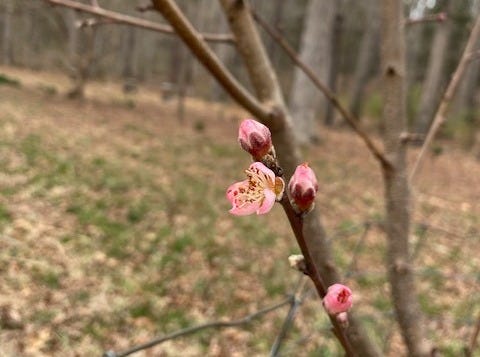3 natural beekeeping practices for spring
Next week is the official start of spring. Here are a few chemical-free methods for spring hive management.
Before we jump in I wanted to share that I’m featured as Beekeeper of the Month by HiveTracks. 🐝
The peach blossoms already opened and the quail have laid their first eggs of the year, so spring may have come a little early. I’m also noticing the bees are behaving a little like it’s summer. They’re congregating at the pond every day—even on the cooler days—which is something they normally do on hot summer days. Since spring officially starts next week, and I host a webinar on the Equinox Eve all about Spring & Summer Natural Beekeeping practices, I thought I’d share 3 chemical-free pest management practices as a sneak peek to the webinar:
Beneficial nematodes. I mentioned in an earlier post how I prepare for small hive beetle management in these earlier months of the year. Small hive beetles are year-round pests. If they overpopulate a healthy colony or infest a weak colony, they can destroy everything. They may make the hive environment so unsanitary that the entire colony absconds—completely abandons their home. Small hive beetles eat everything: honey, pollen, baby bee larvae, wax, you name it. They also defecate and create a mess. Since honey bees are meticulous in their hygiene, they won’t tolerate an infested home. Most colonies are strong enough to manage beetle pressure, but I’ve experienced awful beetle populations. To prevent beetles from getting out of control, I like to use the spring time to proactively reduce the number of new beetles. I do this by applying beneficial nematodes. I applied a strain of nematodes around both of my Pittsboro bee yards earlier this month. Later this month I’ll do the same at my mountain apiary where the beetle pressure is highest. These nematodes burrow into the soil and eat small hive beetle larvae. There are different strains of beneficial nematodes – so I use one in the spring and apply another in the fall to help encourage as much beetle feasting as possible.
Traps. Aside from beneficial nematodes, I’ve had success with Freeman beetle traps. These are modified bottom boards that have a screen separating the colony from a removable tray. You fill the tray with a blend of water and vegetable oil. As the bees naturally police the beetles out of the hive—the beetles fall through the screen and they drown in the tray. You can also encourage bee grooming by sprinkling confectionery sugar. The sugar sprinkling is also a method used in helping to encourage hygienic behavior in managing another pest: Varroa mites. The sugar sprinkling helps increase the number of beetles that drop into the trap. The supplier I bought my original Freeman beetle traps from is out of stock, so I had to track down another supplier. In the past I’ve rotated the traps between colonies—but that’s cumbersome since you need to remove all of the boxes to swap out the bottom board. It also prevents multiple colonies from having the benefit of the trap. This spring I more than doubled more Freeman beetle trap supplies in anticipation of a high pest pressure year.
Spacing and siting. One of my efforts in keeping the hives in a way that mimics nature is spacing the colonies farther apart. Instead of keeping the hives clustered together in one space—which makes it easy for pests like small hive beetles to attack more than 1 colony—I’m spacing my yards farther apart and reducing the number of hives in each yard. It’s a little more work for me to walk between hives (hoping to get a UTV in the near future) but it helps isolate pest pressure. I’m also prioritizing new bee yard sites that have lower densities of pine—small hive beetles are notorious for liking pine-heavy areas.
If you’re curious about more natural beekeeping practices, sign up for my webinar next week.





